THE THEATRE ORGAN
PART FOUR:
THE ELECTRIC-PNEUMATIC SYSTEM
OF THE THEATRE ORGAN
—ooOoo—
ANNOUNCEMENT
-oOo-
Unfortunately, illustrating the numerous concepts and descriptions of the components that come together to make the Theatre Organ do not lend themselves readily to illustration. For example, although a Solenoid is vital to the functioning of the instrument, a photograph of it would add little to the understanding of how it works.
Therefore, this page will be necessarily lacking in illustration. For this I apologise since I appreciate that photographs and pictures help the reader understand and appreciate the text more fully. After all, a picture is worth a thousand words!
Although photographs are rare, those that are present wiIl, I hope, add to the enjoyment of the reader.
To help compensate for the sparsity of photographs, I have added musical interludes from time to time, which I hope will be enjoyed while reading.
The first of these musical interludes clearly demonstrates the dexterity of the organist. Perhaps you will be as amazed by it, as I was when I first watched it:
The Music of Al Jolson
played by Robert Wolfe on the Wurlitzer Theatre Organ of the Thursford Collection, Norfolk
—ooOoo—
The connection between the keys of the manuals and pedals of a Theatre Organ to the prerequisite pipes involves a complex series of ACTIONS that results in sound. Many of these actions have much in common with the system originally used in the Telephone Exchange.
Robert Hope-Jones was able to modify the technology available to him and apply it to the Theatre Organ. His endeavours led to the development of the Electro-Pneumatic Control System for Pipe Organs, whereby air pressure, controlled by an electric current and operated by the Keys of an Organ Console, opens and closes a powerful Pneumatic Bellows that forces a hinged pallet valve open with the subsequent admission of WIND to a pipe and so allow it to speak.
The Wind supplied to the organ is stored in one or more regulators to maintain it at a constant pressure in the Wind Chests until the Action (see below for a full definition on this term) allows it to flow into the pipes.
—ooOoo—
Although this musical interlude has nothing to do with the Theatre Organ,
it is added simply because I enjoy the singing of Kathleen Ferrier and this piece in particular
……. however, it does have WIND in its title!
—ooOoo—
A Telephone Exchange houses equipment that allows the interconnection (i.e. Switching) of individual subscriber lines thereby allowing verbal communication between them. This obviates the necessity for a direct line between each subscriber. As a result, the Telephone Exchange may be considered as a RELAY Centre for the subscribers in the catchment area. Today, this system has grown into a worldwide Public Switched Telephone Network, which developed from the ability of numerous Circuit-Switched Telephone Networks that are operated via national, regional and local telephone exchanges to communicate via their Relay Centres.
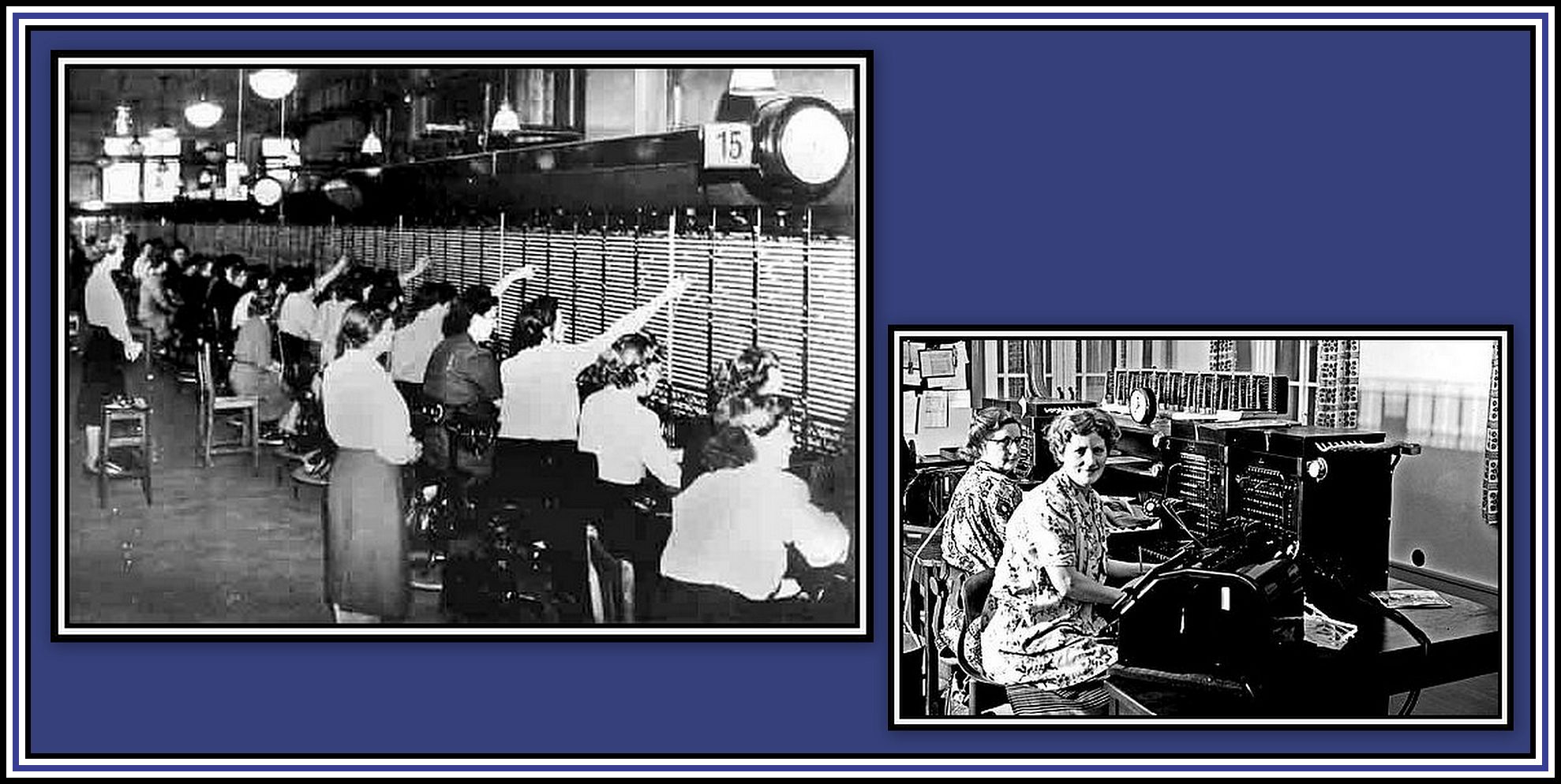 Telephone Operators at earlier Telephone Exchanges
Telephone Operators at earlier Telephone Exchanges
Left: This photograph appears “Courtesy of Pat Cryer, Join me in the 1900s, www.1900s.org.uk“
Right: Telephonists in 1946
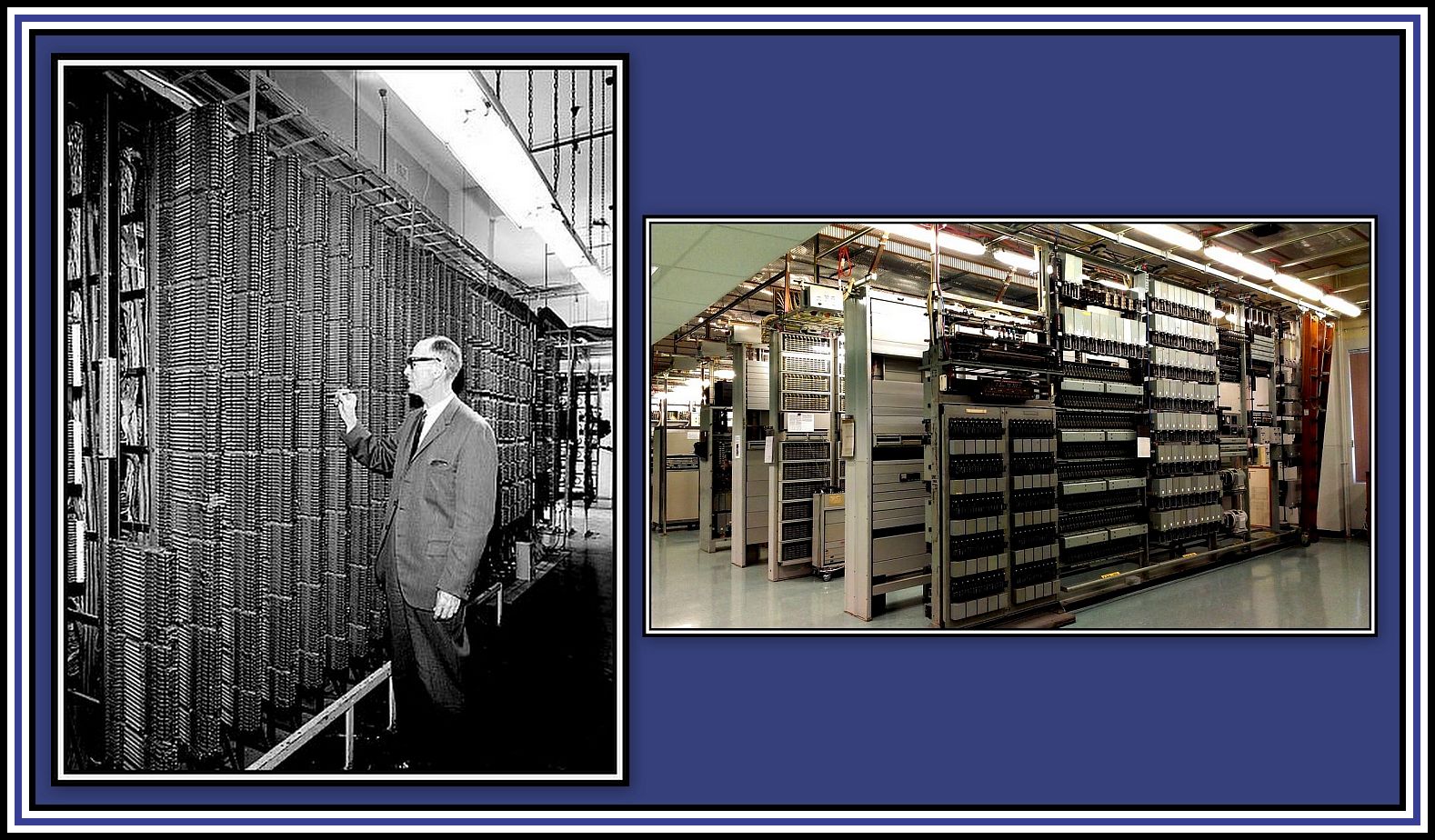 Automated Telephone Exchanges showing the Mulitple Relays in operation
Automated Telephone Exchanges showing the Mulitple Relays in operation
Left: Geelong Telephone Exchange, the first automated Telephone Exchange in Australia
Right: Banks of Relays at the Telstra Museum
This photograph appears at Shack West
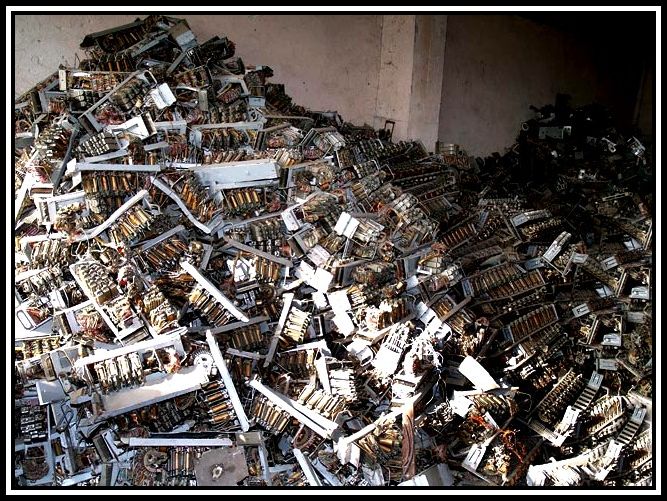 The Fate of the Old Relay System
The Fate of the Old Relay System
—ooOoo—
Following his apprenticeship at a shipbuilders’ company, Mr. Hope-Jones was employed by the Lancashire and Cheshire Telephone Company where he eventually became the Chief Engineer. Later he applied the knowledge gained at the Company to the Pipe Organ and his innovations transformed the instrument into what we know today as the Theatre Organ.
The Pipe Organ had relied on Tracker Action between the keys and the valves of the pipes. When the key is depressed, the corresponding valve is manipulated and allows pressurised air or wind generated by bellows action to enter and produce sound as it escapes the pipe.
![]() Part of the Tracker Action of the Organ of The Church of St. Mary & St. Nicolas, Leatherhead
Part of the Tracker Action of the Organ of The Church of St. Mary & St. Nicolas, Leatherhead
Photograph by Mr. David Oliver and appears here with permission
Click here to see photographs of the installation of the organ at the church
As a result of the imaginative innovations of Robert Hope-Jones who used low-voltage electricity (24 volts) in place of Tracker Action to transmit the depression of the manual keys and pedals to the valves associated with the pipes and so allow the air in and the subsequent production of sound (i.e. speak). In addition, other innovations of Robert Hope-Jones led to the greater range and versatility of possible sounds that could be produced by the Theatre Organ.
—ooOoo—
Time for another musical interlude …….
Click here to hear the great Robinson Cleaver play along with his wife, Molly
—ooOoo—
Through the use of low-voltage electricity, it became possible for the Console of the Theatre Organ, which houses the keyboards, to be linked to the pipes by a flexible WIND LINE (to carry pressurised air to the pipes) and an ELECTRICAL CABLE and so freed it from close proximity to the pipes. This situation is in sharp contrast to that of the Pipe Organ where the Console cannot be moved.
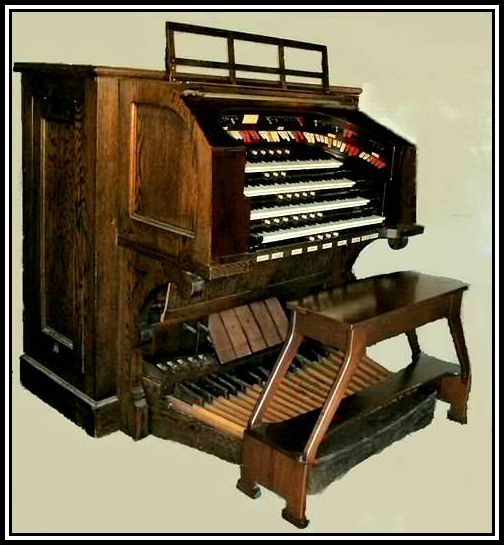 A Hillgreen-Lane Four Manual, 50+ Rank Organ once installed at The Alhambra Theatre Detroit
A Hillgreen-Lane Four Manual, 50+ Rank Organ once installed at The Alhambra Theatre Detroit
This photograph is reproduced from Detroit Cinema History
As a result of the ability to move the Console of the Theatre Organ, it could be placed anywhere in an auditorium including a moveable platform and stored in or beneath the orchestra pit until required. Once needed for accompaniment to a film or for solo interludes, the Console could rise up majestically to stage level in spectacular fashion and bring the audience’s response to its sound and sight to a crescendo.
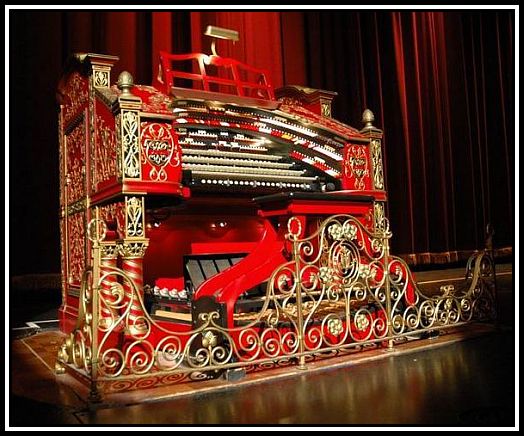 The Console of the Wurlitzer Theatre Organ
The Console of the Wurlitzer Theatre Organ
at the front of the stage of The Alabama Theatre,Birmingham, Alabama
Click on the link below to be able to hear the organ being played
Awaiting permission to reproduce this photograph by
The Alabama Chapter of the American Theatre Organ Society
Click here to see this magnificent Console rise up from the depths and played
—ooOoo—
An organ contains two ACTIONS (or systems) of moving parts. When a Key is depressed, the KEY ACTION admits Wind into a pipe by allowing connection of the KEYS with the WIND CHEST. The STOP ACTION allows the organist to control which Ranks are engaged and so which pipes will be played.
N.B. The KEY ACTION is independent of the STOP ACTION.
An ACTION may be mechanical, pneumatic, or electrical (or some combination of these, such as with the ELECTRO-PNEUMATIC SYSTEM. In the case of the Theatre Organ, an electrical current is used to control the KEY and/or STOP mechanisms. Electricity may control the ACTION indirectly through air pressure valves (i.e. PNEUMATICS), in which case the ACTION is ELECTRO-PNEUMATIC. When electricity operates the ACTION directly without the assistance of PNEUMATICS, it is referred to as DIRECT ELECTRIC ACTION. (These concepts are dealt with in detail below).
—ooOoo—
Click here to hear Walt Strony at the Wurlitzer Theatre Organ of the Radio City Music Hall
—ooOoo—
Let us now consider the complex series of ACTIONS that allow connection between the Keys of the Manuals and Pedals of a Theatre Organ with the prerequisite pipes.
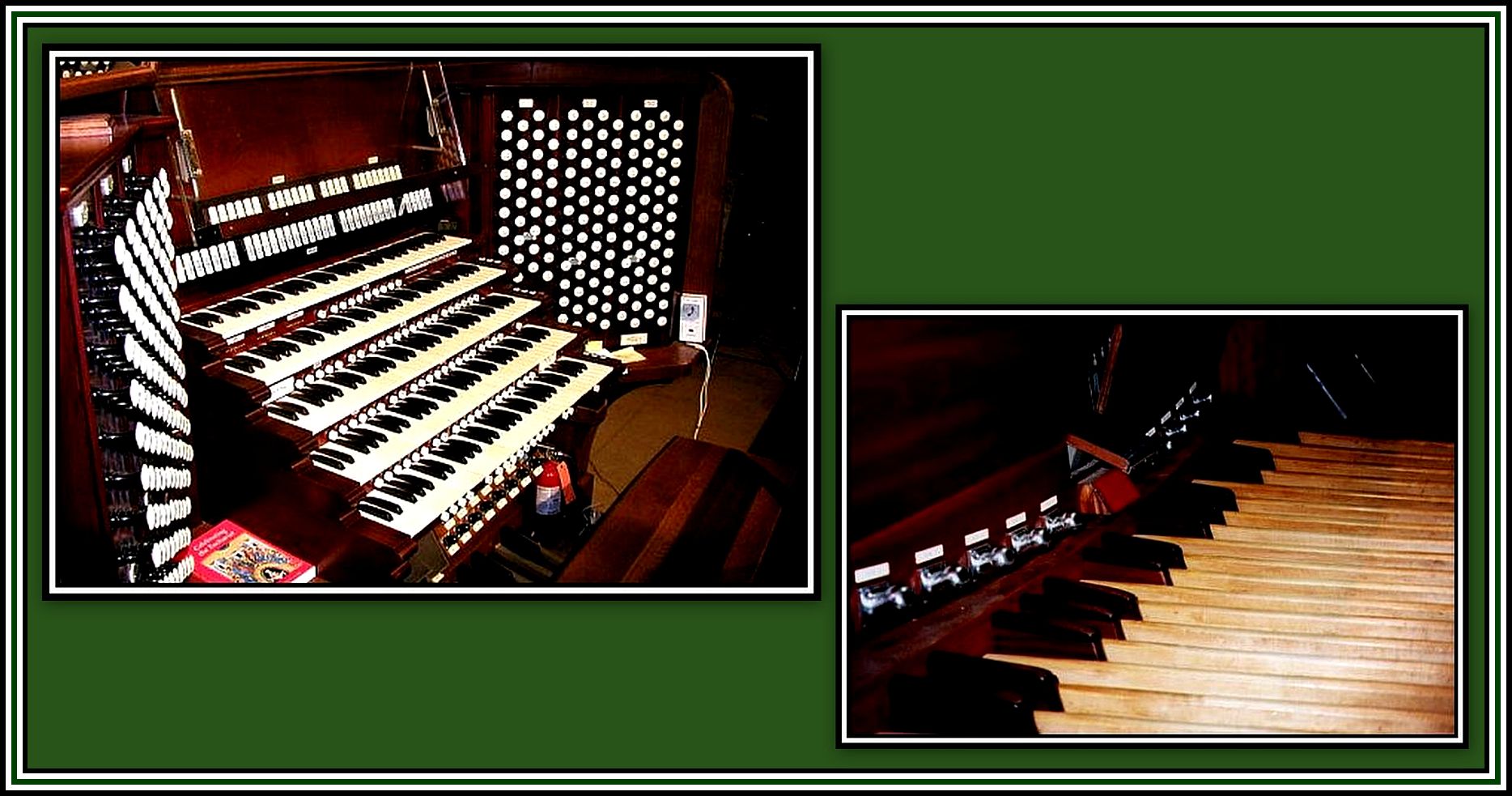 Manuals & Pedals
Manuals & Pedals
Left: The Manuals of St. Patrick Cathedral, New York City
Right: The Pedals of the Lawrenceville School Organ, Methuen, Mass.
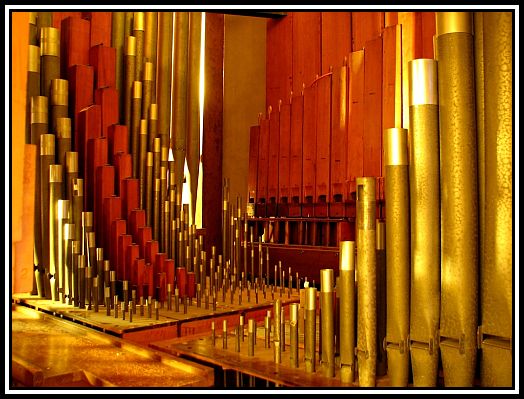 The Organ Pipes of the Organ at Kenrick-Glennon Seminary, St. Louis, Mo.
The Organ Pipes of the Organ at Kenrick-Glennon Seminary, St. Louis, Mo.
This photograph was taken by Steve Geerling
These ACTIONS are the result of the application of a number of simple and basic principles of Physics being brought into play and include those of pneumatics, electrical circuits, magnetism and induction and involve the making and breaking of circuits and the induction of electromagnets, and were used extensively in the development of a RELAY CENTRE or nerve centre of the Organ. In addition, the use of compressed air or WIND is fundamental to the actual playing of both The Pipe and Theatre Organs.
—ooOoo—
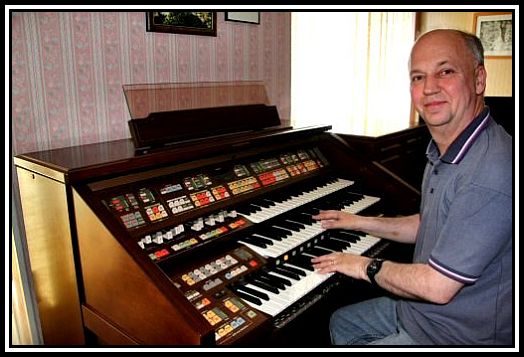 Here Andrew Gilbert play The Floral Dance
Here Andrew Gilbert play The Floral Dance
—ooOoo—
But before discussing the complexities of the ACTIONS involved in the ELECTRIC-PNEUMATIC SYSTEM of the Theatre Organ and the RELAY CENTRE, it would perhaps be of value to define certain terms used in its description:
WHAT IS AN ELECTRIC CURRENT? An electric current is a flow of electric charge. In electric circuits this charge is often carried by moving electrons in a wire. I t can also be carried by ions in an electrolyte or by both ions and electrons such as in a plasma.
WHAT IS MAGNETISM? I am sure that we were all marveled when we discovered the simple magnet: how it stuck to certain metallic objects, how it either attracted or repelled another magnet depending on which end was brought close to it. The principle of magnetism is based on the movement of electrons:
A traditional magnet is the result of the individual motion of the electrons within the individual atoms of the magnet, aligned so that the generated magnetic field is in a uniform direction. In non-magnetic materials, the electrons move in such a way that the individual magnetic fields point in different directions, so they cancel each other out and the net magnetic field generated is negligible.
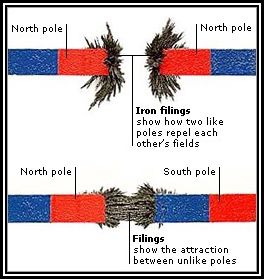 The Law of Magnetism: Like Poles Repel and Opposite Poles Attract
The Law of Magnetism: Like Poles Repel and Opposite Poles Attract
This photograph appears at Fact Monster
 A Magnet generates a Magnetic Field around it (Upper) which may be shown to be present by scattering a substance with magnetic properties ( e.g. iron filings) around it (Lower)
A Magnet generates a Magnetic Field around it (Upper) which may be shown to be present by scattering a substance with magnetic properties ( e.g. iron filings) around it (Lower)
WHAT IS INDUCTION? I am sure that at some time we all have wondered how sound is produced from an old-fashioned door bell by simply pressing the button.
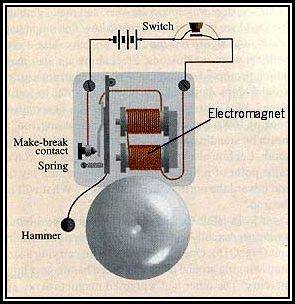 The Electrical Circuit of a Doorbell
The Electrical Circuit of a Doorbell
Here a magnetic field is induced by the flow of an electric current
through the coil when the circuit is complete
Electromagnetic induction (or sometimes just induction) is a process where a conductor placed in a changing magnetic field (or a conductor moving through a stationary magnetic field) causes the production of a voltage across the conductor. This process of electromagnetic induction, in turn, causes an electrical current – it is said to induce the current.
WHAT IS A SOLENOID? A Solenoid is a coil wound into a tightly packed helix. In Physics, the term refers specifically to a long, thin loop of wire, often wrapped around a metallic core, which produces a uniform magnetic field (i.e. the magnetic influence of electric currents and magnetic materials) in a volume of space when an electric current is passed through it. A Solenoid is a type of electromagnet when the purpose is to generate a controlled magnetic field. A Solenoid Switch is a specific type of RELAY that internally uses an Electromechanical Solenoid to operate an Electrical Switch (see below for a definition of a RELAY).
—oooOooo—
Time for another musical interlude
Click here to hear Simon Gledhill at the Wurlitzer Theatre Organ of the Tower Ballroom Blackpool
—oooOooo—
WHAT IS A SWITCH? A Switch is an electrical component that can break an electrical circuit by interrupting the current or by diverting it from one conductor to another. A simple example of this device is the Electric Light Switch.
WHAT IS AN ACTION? (see above) As an organ is played, the KEYS, STOPS, and WIND CHEST work together as a mechanism, known as an ACTION, to direct pressurised air (i.e. WIND) into the pipes, which produces the sound.
In the case of the Theatre Organ, the ACTION is assisted by electrical means to transmit the signal from the Console via the RELAY, and PNEUMATICS to amplify the signal to open the valve that admits WIND from the WIND CHEST into the pipe.
WHAT IS A WIND CHEST? A WIND CHEST is a component of an organ on which the pipes sit and consists of long wooden boxes which contain the valve mechanisms (i.e. the ACTION) for the admission of air into a pipe.
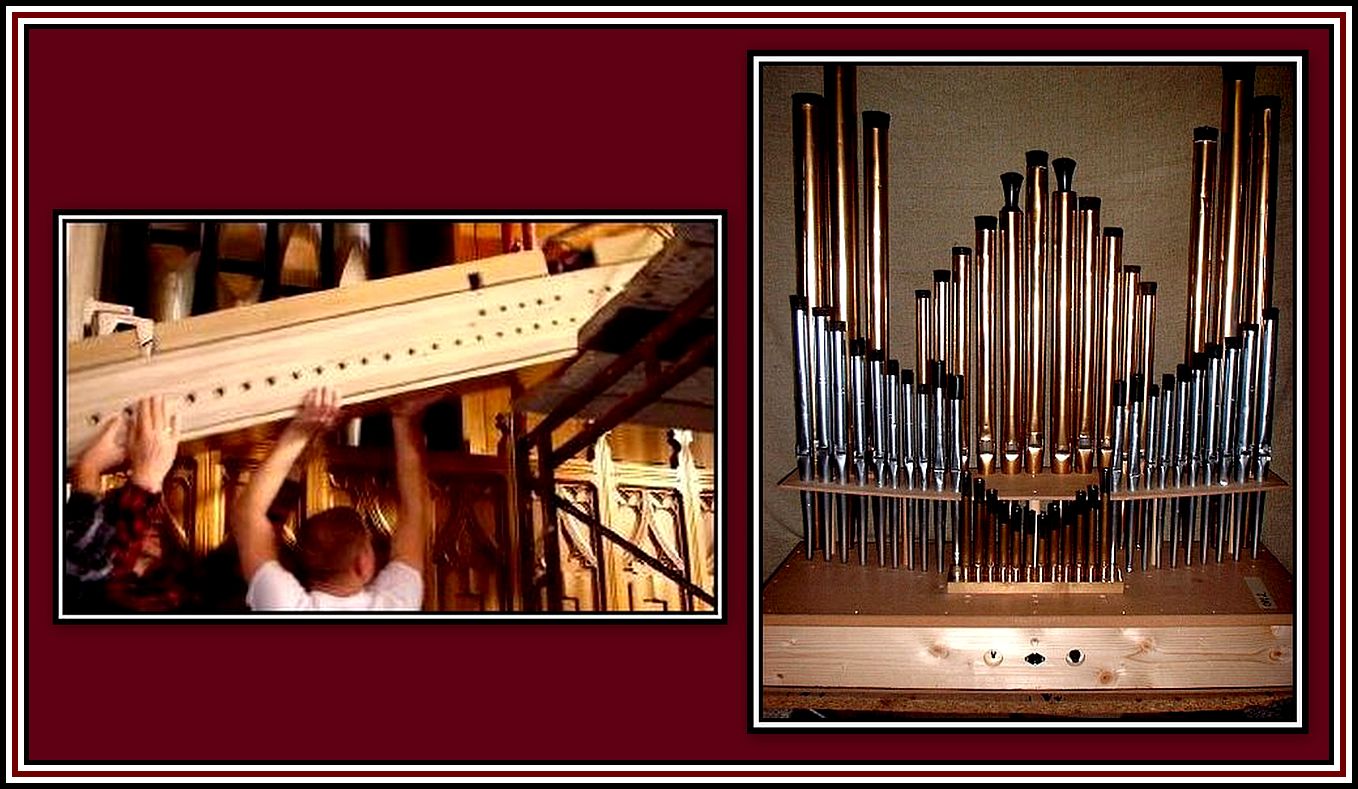 Examples of Wind Chests
Examples of Wind Chests
Left: a Wind Chest being put in position
Right: Pipes sitting on the Wind Chest
WHAT IS PNEUMATICS? This is the area of technology that relates to the study and application of pressurised gases to produce mechanical motion and is used extensively in industry. In addition, compressed air has been used to operate the Solenoid valves used to produce the sound of a Theatre Organ. Such a system can often provide motive power that is cheaper, more flexible and more reliable than through the use of electric motors and actuators.
WHAT IS A PNEUMATIC or MOTOR? A PNEUMATIC is effectively a tiny bellows made of two pieces of wood joined by thin leather gussets, which opens and closes the valve (also called a pallet) that allows pressurised WIND to enter the bottom of a pipe. In Wurlitzer Organ WIND CHESTS, there are typically two pneumatics: a primary and a secondary pneumatic. The use of double pneumatics ensures a fast action when high wind pressure is employed, as is the case with the Theatre Organ.
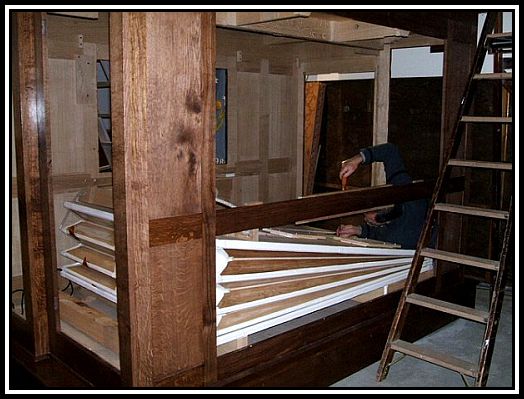 The Bellows of the Organ of The Church of St. Mary & St. Nicolas, Leatherhead
The Bellows of the Organ of The Church of St. Mary & St. Nicolas, Leatherhead
Photograph by Mr. David Oliver and appears here with permission
Click here to see photographs of the installation of the organ at the church
A PNEUMATIC or MOTOR may be either to fill with air or empty of it. When emptied, the PNEUMATIC is said to have been EXHAUSTED.
—ooOoo—
Before launching into the RELAY, there will be another video & musical interlude
Click Here to watch Wurlitzer in the House
—ooOoo—
WHAT IS A RELAY? It is an electrically operated switch. Many use an electromagnet to mechanically operate the Switch. It is the generic term given to the electrical means by which the Console is connected to the pipe work and percussions.
Click here to see how a simple RELAY works
RELAYS are used where it is necessary to control a circuit by a low-power signal or where several circuits must be controlled by one signal. The first Relays were used in long distance Telegraph circuits as amplifiers: they repeated the signal coming in from one circuit and re-transmitted it on another circuit. RELAYS were used extensively in Telephone Exchanges and early computers to perform logical operations.
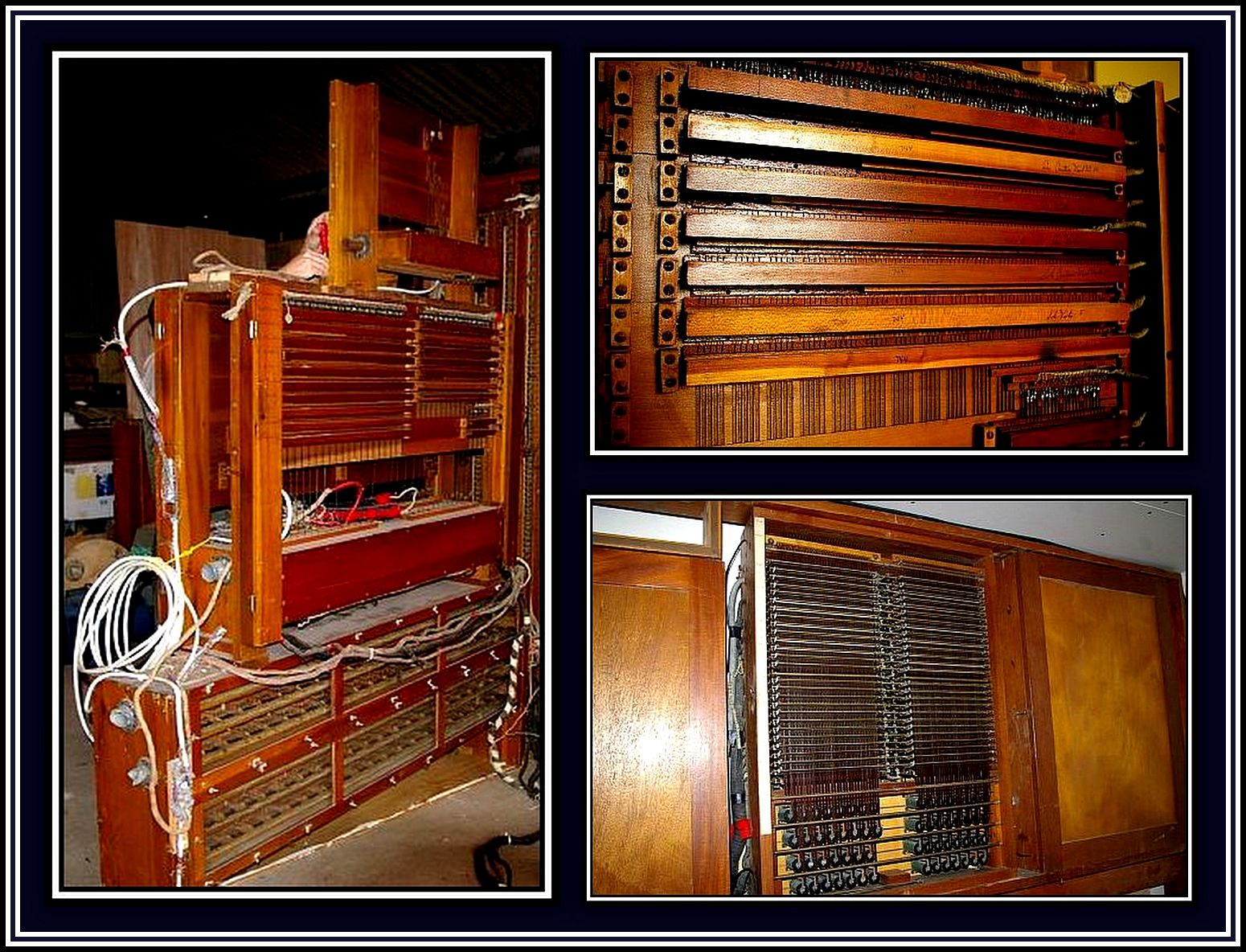 Part of the Theatre Organ Relay System
Part of the Theatre Organ Relay System
Left: Decca Studio Wurlitzer Organ Relay
Top Right: Switch Stack of Decca Studio Relay
Botom Right: Relay System of the Compton Organ once installed at the Granada Theatre Dartford
These photographs appear with permission of Mr. Wayne Ivany
A simple electromagnetic Relay consists of:
- a coil of wire wrapped around a soft iron core,
- an iron yoke (i.e. supports the pole core and forms a part of the magnetic circuit) which provides a low Reluctance path (i.e. Reluctance is analogous to Resistance in an electric circuit) for magnetic flux and
- a movable iron ARMATURE (a definition for this term is given below), and • one or more sets of contact.
For those readers wishing to learn more about RELAYS, here are some short videos on the subject:
Click here to view the video, THE LATCHING RELAY CIRCUIT
Click here to view the video, WHAT IS A RELAY?
Click here to view the video, HOW A RELAY WORKS
The ARMATURE is hinged to the yoke and mechanically linked to one or more sets of moving contacts.
When an electric current is passed through the coil it generates a magnetic field that activates the ARMATURE and the consequent movement of the movable contact(s) either makes or breaks (depending upon construction) a connection with a fixed contact.
The RELAY SYSTEM of a Theatre Organ allows the Console from having to be directly and mechanically connected to the pipe Wind Chests themselves. This concept is vital in the understanding the freedom allowed the Theatre Organ, which is in direct contrast to the situation of the Pipe Organ, where the Console cannot be moved from the vicinity of the pipes.
WHAT IS AN ARMATURE? An Armature is the POLE PIECE (i.e. serves to direct the magnetic field produced by a magnet) of a permanent magnet or electromagnet or the moving iron part of a SOLENOID or RELAY.
An example of a simple POLE PIECE is a magnet KEEPER. A Keeper serves to connect the two poles of a magnet while not in use.
A specialised POLE PIECE is the ARMATURE of an electromechanical Solenoid and produces a mechanical force when attracted by an electromagnet once the magnet is actuated (i.e. brought into effect). In the case of the Theatre Organ, the generation of the mechanical force here serves TO OPEN THE VALVES connecting the WIND CHEST with the pipes.
The other component of an Armature is the FIELD WINDING or FIELD MAGNET. The role of the field component is to create a magnetic field (magnetic flux) for the Armature to interact with.
—ooOoo—
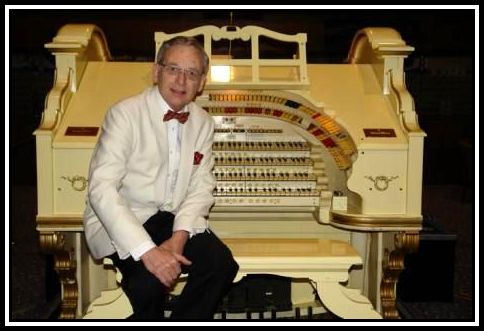 Click here to hear Len Rawle MBE playing the Wurlitzer and Hammond Organs
Click here to hear Len Rawle MBE playing the Wurlitzer and Hammond Organs
at a concert given at St. Albans Organ Theatre
—ooOoo—
WHAT IS A GENERATOR? An electrical GENERATOR is a machine which converts mechanical energy (or power) into electrical energy (or power). A MOTOR converts electrical energy into mechanical energy.
Click here to learn … How DC Generators Work
—ooOoo—
There are two systems that allow the valves beneath the pipes of a Theatre Organ to open and so allow entrance of the Wind and the subsequent production of sound:
• the Electric-Pneumatic System and
• by Direct Electric Action.
-oOo-
Robert Hope-Jones developed an Electric-Pneumatic System for the operation of the Theatre Organ that including a rotating centrifugal air blower and employed a DC Generator in place of banks of batteries to provide the electrical power to the organ.
The innovations applied to the Theatre Organ by Mr. Hope Jones and which were later employed by the Ruldolph Wurlitzer Company, allowed the organist’s actions at the Console to be transmitted firstly to an Electro-Pneumatic Relay System and then transmitted to the pipes in the organ chambers.
—ooOoo—
Let us now return to the ACTIONS of the Theatre Organ and consider them in more detail:
When a STOP TAB at the Console for a specific set (Rank) of Pipes to be played is depressed, a Stack Switch moves up and is activated (i.e. an electric circuit is completed). There is one Switch for each STOP TAB present on the Console.
Similarly, with the depression of a KEY of the manual or keyboard, an electric circuit is completed by way of a Switch connected to it.
Each KEY is associated with a small electromagnet present in the WIND CHEST, which is activated (i.e. energized, causing the Armature to move position) when this KEY is depressed. As a result, a small valve opens, which allows a bellows or wind source to operate a larger valve that now induces a change of air pressure within the area (i.e. called the channel) leading to those pipes associated with the particular KEY being depressed.
In the case of the Electric-Pneumatic System, a separate Stop Action system is employed to control the introduction of Wind into the pipes of the Rank or Ranks that were selected for playing once the STOP TAB on the Console was engaged.
However with the Direct Electric Action System, the control of Wind entering into the pipes of a Theatre Organ once the corresponding Keys or Pedals are depressed relies on the valves (pallets) beneath the pipes being opened directly by Electromagnet Solenoids that are directly attached to them. With this system, there is no pneumatic. The Wicks Company favoured this type of action in their church organs since it was less costly as it required fewer parts.
Click here to here Robinson Cleaver at the Wuritzer Theatre Organ of the Granada Theatre Tooting
The Electric-Pneumatic System is faster operating than Direct Electric Action and uses less current to function causing less demand on Switch contacts. In addition, the opening and closing of the valves (pallets) is also cleaner with the Electric-Pneumatic System, as it allows for fast repetition of notes and a more articulate playing of fast-paced music. An organ employing the Electro-Pneumatic System was more reliable in operation than early Direct Action Organs until improvements were made in Direct Electric components.
Numerous electrical components are used to translate the organist’s wishes into sound with many of these components were brought together in the Relay system. Solenoids are used to operate the numerous Stop Tabs, Controls, Keys and Pedals of the Console, as well as the Pipe valves (pallets).
The Relay System of the Theatre Organ may be likened to a nerve centre (i.e. brain) and is an example of an early computerised system. With the increase in the number of manuals and Ranks of pipes of the Theatre Organ, the matrix of possible connections in its Relay System can be in the thousands. The Relay is able to process huge numbers of connections (i.e. operations) simultaneously, from dozens to almost a hundred, and are processed (i.e. connect and disconnect) in a fraction of a second.
Relay Systems fall into two categories, Stop-switch Relays, favoured with Wurlitzer and Christie Organs and Matrix Relays, favoured by Compton Organs.
A major disadvantage of the Theatre Organ’s Electric-Pneumatic System is that the Relay System requires housing in a large space. Despite the complexity of the Relay, it proved to be remarkably efficient and resilient and was in widespread use until Solid State Digital Electronics were applied to the System. The development of suitable computer software in the form of small circuit boards can now replace the huge Relay System and so greatly reduce space requirements.
Today, organ builders regularly employ a computer in place of the traditional Relay System. This consists of a small number of computer boards that are often mounted on a wall unlike the erstwhile Relay System that required a huge volume of space and a large amount of electrical wire. With each Stop Key and Key being wired, the transmission cable leading from the Console could easily contain several hundred wires. The number of wires required between the Manuals, the Relay System, the Wind Chest and Pipes, with each Solenoid requiring its own signal wire, could prove problematic if a wire was broken and needed to be traced. This problem increased in proportion of the size of the Theatre Organ where the largest could contain over a hundred thousand miles of wiring. This problem does not occur with Solid State Digital Electronic Switching Methods.
—ooOoo—
Click here to hear Robert Wolfe play the Wurlitzer Theatre Organ of the Thursford Collection
—ooOoo—
Unification allows the organist to produce a much greater variety of sound combinations from an organ of given size than would be possible without it. Prior to this, there was one pipe for each Key on the Keyboard. Unification allows any number of Stop Tabs to be played simultaneously from any of the manuals or pedal keyboard and at any desired pitch (i.e. fewer Ranks, but with more Pipes, could be used in a wide variety of combinations and pitches, and on different manuals at the same time). The notes played may be in Octave relationships or may be pitch offsets, which add Tone Colour (i.e. Timbre) to the music. Wurlitzer Theatre Organs allowed extensive use of this ability.
Previously, each Rank of Pipes could be played on only one manual (keyboard) at one pitch level. A rank is one graduated set of similar pipes that produces a distinct “sound” or tonal color. In other words, there was one pipe for each key on the keyboard. With the advent of unification, Ranks were extended by adding more Pipes and made playable at different pitch levels, and on different manuals. Thus, fewer Ranks, but with more Pipes could be used in a wide variety of combinations and pitches, and on different manuals simultaneously.
Extension refers to the addition of extra Pipes to the high and/or low ends of a Rank in order to allow that Rank to be borrowed by higher and/or lower Stops.
Unification and Extension were used to great effect in Theatre Organs and produce the maximum number of voices from a minimal number of Pipes.
—ooOoo—
Despite my attempting to describe and explain the working of a Theatre Organ, I have to admit that when I sit in a cinema and the lights go down and suddenly the limelight falls on an empty area at the centre of stage front and then hear dulcet tones coming from under the stage, the hair at the back of my neck stands up and I KNOW how it works!
The trapdoor opens and the music is now louder and then ……… WHOOSH! This magnificent instrument ascends from its hidden place, generally accompanied by a wave of the organist’s hand, and is greeted by an explosion of applause from a grateful public.
Click here to see one of these magnificent instruments rise up from the depths
Now I am CONVINCED that I know how it works!
From the sound of the first note, all thoughts of solenoids, wind chests, relay systems, the advantages of the Electro-Pneumatic System etc etc etc are chased from my mind!
Now I know ……. the instrument works by MAGIC!
Nothing but pure, unadulterated MAGIC ……. plain and simple ……. could have this effect on an audience and no one will convince me otherwise ……….. as long as the organ is being played, that is!!!
—ooOoo—
I recommend that you take a few minutes to watch the excellent video,
MEET THE ORGAN – SYDNEY
where you get to see the organ behind the scenes.
——-oooOOOooo——-
I am honoured to have received a note from Mr. Len Rawle, M.B.E. where he says:
Congratulations on your well researched work – great reading.
——-oooOOOooo——-
ACKNOWLEDGEMENTS
I would like to thank Mr. Wayne Ivany for his help in producing this piece and to all others that have allowed their photographs to appear here.
I would also like to thank Mr. Simon Glenhill and Mr. Andrew Gilbert for their expertise and help.
I would also like to thank Mr. Len Rawle for his kind comment.
Finally, I would like to thank Mr. Gerald C. Starkeson for his help in the writing of the text.
——oooOOOooo——
Click here to GO to: THE WANAMAKER ORGAN HOME PAGE
——oooOOOooo——
Click here to return to PART THREE:
THE THEATRE ORGANS & ORGANISTS OF
THE GRANADA THEATRE CIRCUIT
——oooOOOooo——
Click here to return to PART TWO:
THE THEATRE ORGAN Home Page
——oooOOOooo——
Click here to return to the TABLE OF CONTENTS
——oooOOOooo——

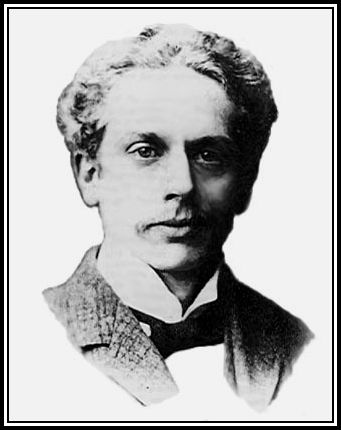
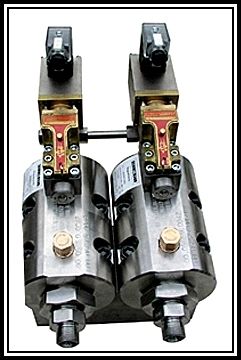
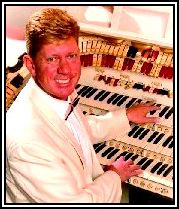

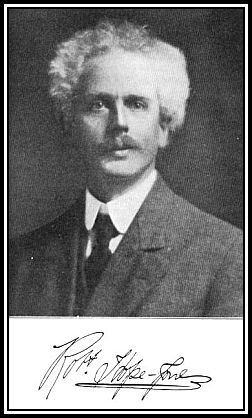

Thank you so much for this fascinating and detailed series on the organ. I enjoyed reading it very much indeed and watching the various videos you included in the articles.
Hello Sales,
We are looking to purchase the item below:
Festo Valve 6211 MFH-5-1/4
Payment Terms: Net 15 Days
Daniel William
University of California, Los Angeles (UCLA)
405 Hilgard Avenue
Los Angeles, CA 90095
Have sent you a reply to your email address.